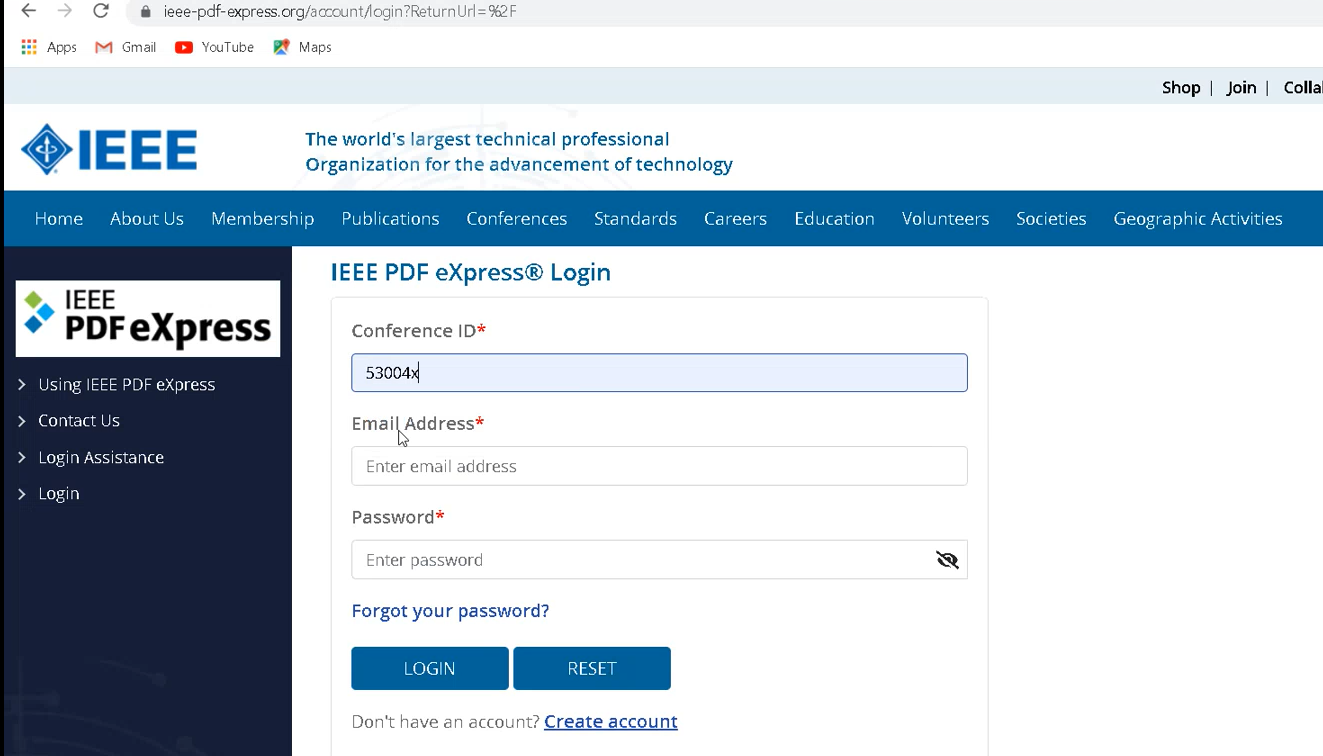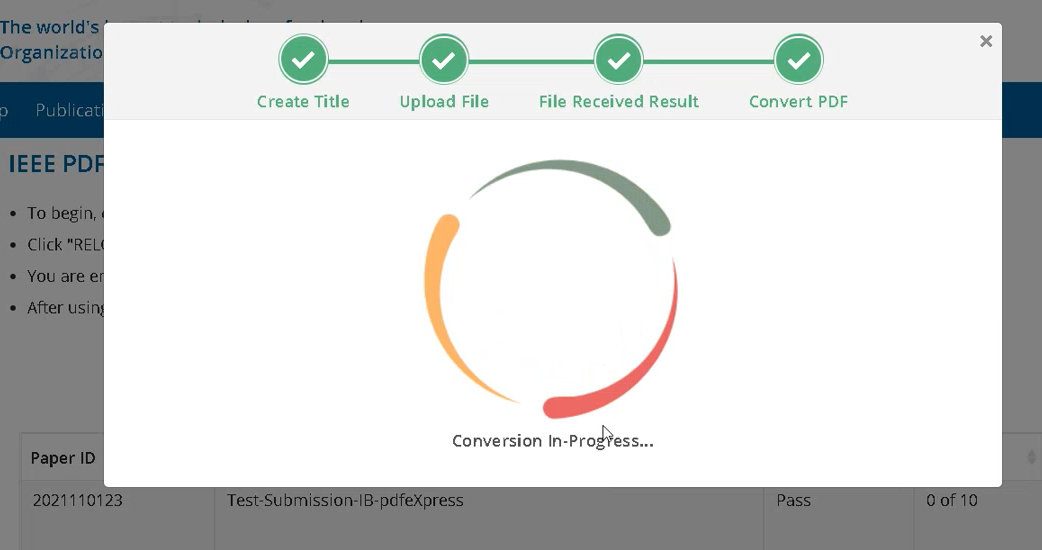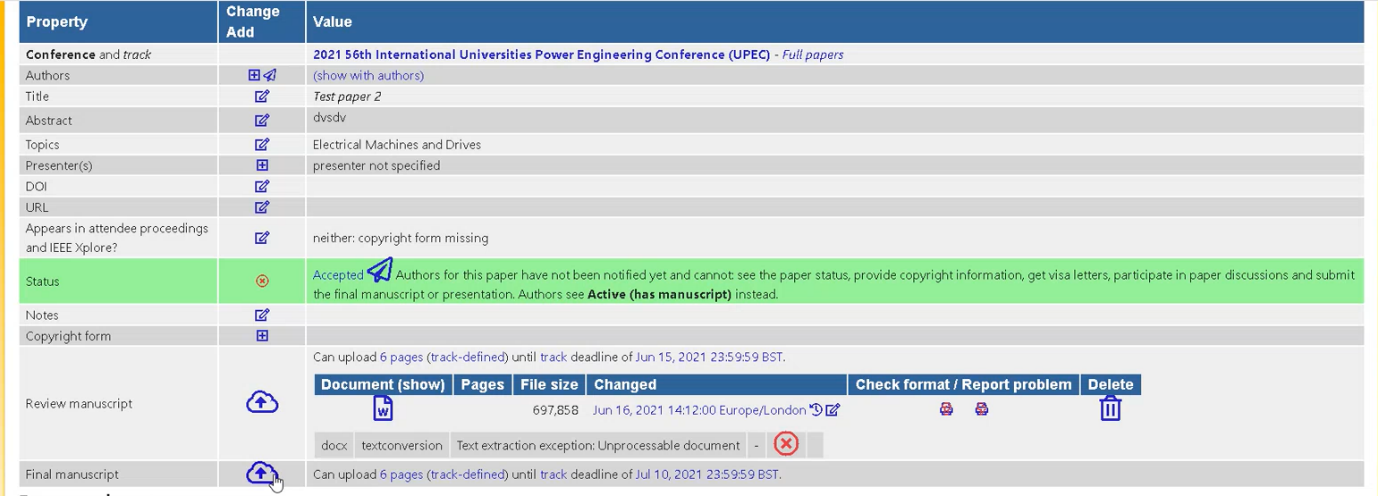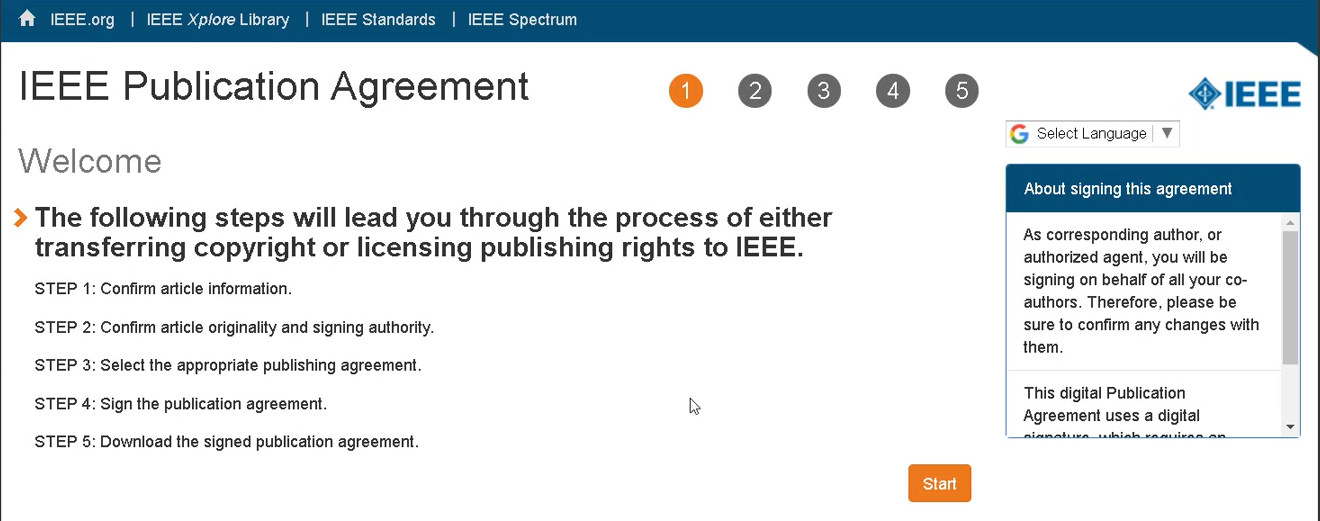AUTHORS
BEFORE THE CONFERENCE
- Registered participants have been emailed sign up information from Whova our conference management platform. The non-live portion of the conference technical programme can be now accessed and viewed via Whova.
- The conference technical programme agenda is available to view now. Please see the Programme tab of this website. You can download sessions of interest as a calendar file and add to your calendars.
- Please complete the conference confidentiality agreement if you haven’t done so already: https://forms.office.com/r/mvhJ0hfKrD
- Please see the linked guide on how to use Whova and its different features: https://whova.com/pages/whova-app-user-guide/?source=ems
- Please see the instructions on our blog on accessing the provisional technical programme via Whova: https://blogs.tees.ac.uk/56upecconference/
- The papers and pre-recorded presentations are viewable via Whova, do view as many as you like and put any questions to session panels using the chat feature available within Whova
- If you are a presenting author, make sure you know how to join the live sessions. Organisers will be emailing you the instructions.
- There are lots of activities on the conference platform to get involved with, add you profile, set up some networking, check out the training, look at the sponsored material
- All the plenary and panel sessions will be recorded, so if session timings were inconvenient in your time zone you can ask questions ahead of the sessions and watch the recorded video at your convenience when it is available after the session.
DURING THE CONFERENCE
- Join the pre-conference Check-in/Training/ Connection testing session on Monday 31st August if you are a presenter and are not sure how to join your live panel session.
- Check the agenda on Whova and bookmark all the sessions you want to view
- Join the sessions you want to view at the right time, the times are set to your local time.
- Ask questions in the chat
- If you are a presenting author, you must join the live session as per the email instructions for the session.
- If you have any technical issues on the day, please don't worry, just follow the instructions organisers email you on reporting technical issues.
- Don't forget to view the industry webinars from the sponsors on one of the conference days.
- Join the end of day networking and use the call and chat features of Whova to set up meetings with possible future collaborators.
AFTER THE CONFERENCE
- You can still view the recordings of the sessions, access the proceedings, and read the papers via Whova for around 6 months from the end of the conference.
- Look out for emails from organisers on the Special Journal Issues.
- Work on a substantially extended version of your UPEC paper and submit it to the journal Special Issue
JOURNAL SPECIAL ISSUE
The authors of registered papers presented at UPEC 2021 will be invited to submit a substantially extended version to one of two Special Issues, both titled "Powering Net Zero Emissions - Selected Papers from the 56th International Universities Power Engineering Conference (UPEC 2021)", first from MDPI Electronics journal and the second from MDPI Electronics journal.
Special issue information for MDPI Electronics can be found here.
Special issue information for MDPI Energies can be found here.
https://www.mdpi.com/journal/electronics/special_issues/Powering_Zero_EmissionsAwards
There will be 4 awards for UPEC 2021:
- A best paper award and a best presentation from a presenter under 30 award of £400 each sponsored by MDPI Electronics.
- A best paper award and a best presentation from a presenter under 30 award of £400 each sponsored by MDPI Energies.


-
PRE-RECORDED VIDEO PRESENTATION SUBMISSION
PRE-RECORDED VIDEO PRESENTATION SUBMISSION
The technical programme of UPEC 2021 will be hosted using the virtual conference platform Whova. To allow participants across the globe to have access to the technical content, all authors of accepted and registered papers are required to submit a video presentation of their work and accompanying slides by 2 August 2021 to EDAS. The presentations and slides will be available to watch on demand to participants through Whova before, during and after the conference for a few months (exact dates to be confirmed in due course).
During the conference, one of the registered authors representing the paper will also be expected to present a short "elevator pitch" to prompt an interactive discussion within themed panel sessions that considers the paper. This will be a 2-minute summary of the paper with one accompanying slide.
-
PRESENTATION SLIDES
PRESENTATION SLIDES
Please use the conference PowerPoint template available here.
The pre-recorded video presentation is expected to be a maximum of 10 minutes. So, we recommend 1 slide per minute. It is also essential to include a summary slide for the "elevator pitch".
The order given here is indicative of how to organise the presentation, it is fine to adapt it to your specific work.
Slide 1: Title Slide
Slide 2: Introduction- General context
- Notes on the state of the art
- Research gap(s)
- Main unsolved issues
-
Slide 4: New contributions
- Proposed advances to the state of the art
- Hypotheses
- Formulation
- (Highlight the main novel elements of the proposed approach)
- (Avoid the inclusion of too many equations)
- (Explain the symbols used)
- Graphs / Tables
- Comments
- Main findings
- Specific remarks
Slide 11: Separator slide (retain it as it is)
Slide 12: Elevator pitch summary slide for panel discussion.
The presentation slides can be uploaded to EDAS in PowerPoint or PDF format.
-
PAPER VIDEO PRESENTATION INSTRUCTIONS
PAPER VIDEO PRESENTATION INSTRUCTIONS
The presentation can be recorded by any of the co-authors named on the paper. Please prepare and upload a video of your presentation, comprised of a brief introduction with webcam, if desired, followed by voice over slides for your presentation. This is a requirement for your paper to appear in IEEE Xplore. Please note that the file must be a video file in MP4 format (more details below). Please do not try to upload PowerPoint or PDF files.
There are several video conferencing tools available to easily record a presentation. With this method, you may show your face via webcam (if you'd like) and display your slides as you talk. You may use any meeting software as long as you get a good quality recording and your final file is in the MP4 format. Here are some links to instructions on recording a meeting on common platforms:
- WebEx: Video Conferencing - Record a Cisco Webex Meeting
- Skype: Skype for Business: Recording a Meeting | Information Technology Services | Bemidji State University
- Google Meet: Record a video meeting - Meet Help
- Zoom: Local Recording – Zoom Help Center
- Gotomeeting: How to Record a GoToMeeting Session | Techwalla and How to Convert and Open the GoToMeeting Recordings
- Microsoft Teams: Record a meeting in Teams - Office Support
For authors who are not able to use any of the above methods, you can use the free software ActivePresenter, which allows you to simultaneously capture yourself while speaking and your slides: https://atomisystems.com/download/?__c=1
You can also use the two-step method covered below:
-
GUIDELINES FOR PREPARING YOUR VIDEO
GUIDELINES FOR PREPARING YOUR VIDEO
- Duration: 10 minutes
- File size: 250MB max
- Video file format: mp4
- Dimensions: Minimum height 720 pixels, aspect ratio: 16:9
Please note the final specifications will be checked at the time of submission and files not compliant may not be uploaded.
Please be sure to use the UPEC 2021 presentation template for your slides in the video.
TIPS FOR RECORDING
- 1. Use as quiet an area as possible
- 2. Avoid areas with echo so:
- a. Rooms should be fairly small
- b. Sound dampening with carpeting, curtains, furniture
- 3. Hardline internet connection recommended, but if unavailable, a strong Wi-Fi connection
- 4. Good headset with microphone close to mouth BUT away from direct line of mouth to reduce "pops". Avoid using default built-in microphone on computer.
- 5. Do a test recording of a couple of minutes and review the sound and picture quality, MP4 format, and bit rate before recording the entire presentation. Make adjustments if needed.
UPLOADING YOUR PRESENTATION SLIDES AND VIDEO RECORDING (DEADLINE: 2 AUGUST 2021)
- 1. Go to EDAS
- 2. Go to My Papers
- 3. Click on your paper title
- 4. Click on presenting-author

- 5. Click on Video Presentation

Upload your MP4 video file to your paper record. - 6. Click on Presentation-slides

Upload your PowerPoint or PDF presentation slides to your paper record.
Answer the questions on presenting author and age and click submit:

If you have any issues with uploading your video recording or presentation slides, please contact us at: adminupec2021@tees.ac.ukImportant: videos that are not received by the deadline will be considered no-shows in accordance with the IEEE non-presented paper policy.
Instructions for Camera-Ready Paper Submissions
Final camera-ready papers are due no later than July 10, 2021.
-
Instructions for Camera-Ready Paper Submissions
All final camera-ready paper submissions are through the same online system EDAS https://edas.info/28304. Please ensure that all details such as all author names are included, authors names are in the right order and the paper title is included in the online submission system properly, as these data will be used to generate the conference technical programme and the table of contents for the proceedings.
As in the case of the full paper submission for review, all camera-ready version of the papers must be prepared in English and with a maximum page limit of six (6) pages using the IEEE A4 conference template which can be found here https://www.ieee.org/conferences/publishing/templates.html
Please consider the following steps for properly submitting the final version of your paper:
1: Update/revise your accepted manuscript
Please make sure to read the reviews of your paper and take them into account for the final revision. Furthermore, make sure that your manuscript is double-checked for typos and language mistakes.
Paper must be re-submitted in a camera-ready version even if the reviewers indicated that no changes are required to the manuscript submitted at the review stage.
If your paper has been conditionally accepted and you would like to provide a response to reviewers, please email you response to AdminUPEC2021@tees.ac.uk quoting the EDAS id of the paper. For other accepted papers there is no expectation for you to provide a response to reviewers by email.
We will be conducting an editorial check for all papers to see if concerns raised in review comments have been addressed.
2: Insert the IEEE copyright clearance code
The appropriate copyright clearance code notice is to appear at the bottom of the first page of each paper according to the guidelines set forth in the Cataloguing/Copyright Instructions for an IEEE Conference Proceeding. The copyright notice should appear about 1 cm below the left column and should be aligned to the left with the same left margin as the column.
The appropriate copyright clearance code notice is to appear at the bottom of the first page of each paper according to the guidelines set forth in the Cataloguing/Copyright Instructions for an IEEE Conference Proceeding. The copyright notice should appear about 1 cm below the left column and should be aligned to the left with the same left margin as the column.
- For papers in which all authors are employed by the US government, the copyright notice is:
U.S. Government work not protected by U.S. copyright - For papers in which all authors are employed by a Crown government (UK, Canada, and Australia), the copyright notice is:
978-1-6654-4389-0/21/$31.00 ©2021 Crown - For papers in which all authors are employed by the European Union, the copyright notice is:
978-1-6654-4389-0/21/$31.00 ©2021 European Union - For all other papers the copyright notice is:
978-1-6654-4389-0/21/$31.00 ©2021 IEEE
- For papers in which all authors are employed by the US government, the copyright notice is:
U.S. Government work not protected by U.S. copyright - For papers in which all authors are employed by a Crown government (UK, Canada, and Australia), the copyright notice is:
978-1-6654-4407-1/21/$31.00 ©2021 Crown - For papers in which all authors are employed by the European Union, the copyright notice is:
978-1-6654-4407-1/21/$31.00 ©2021 European Union - For all other papers the copyright notice is: 978-1-6654-4407-1/21/$31.00 ©2021 IEEE
How to add IEEE copyright notice?
MS Word users please use the IEEE A4 word template
Latex users can add following lines just before \begin{document} for the copyright notice to show up in the IEEE latex template:\makeatletter
\def\ps@IEEEtitlepagestyle{%
\def\@oddfoot{\mycopyrightnotice}%
\def\@evenfoot{}%
}
\def\mycopyrightnotice{%
{\footnotesize 978-1-6654-4389-0/21/\$31.00~\copyright~2021 IEEE\hfill} % Revise this line accordingly
\gdef\mycopyrightnotice{}
}3: IEEE PDF eXpress
All final manuscripts must be generated using the PDF eXpress tool. To generate the IEEE Xplore compatible PDF file of your paper, follow these steps:
- a) If you do not already have an account, create your IEEE PDF eXpress account: https://ieee-pdf-express.org/
- b) Use the Conference ID: 50034X
- c) The first time you access the system, please follow the link to new user. Please note that in order to access the service, you need to allow the use of cookies from the PDF eXpress web site.
- d) Following this, you can upload your final camera-ready version of the paper to check its compatibility and generate an IEEEXplore compatible version certified by PDF eXpress.



4. Completion of the IEEE Copyright Transfer
The IEEE copyright transfer agreement must be submitted electronically via EDAS. Logging to EDAS and go to your papers page. Use IEEE Copyright Submission button and follow all next steps to sign the copyright electronically.




5. Upload the prepared camera-ready manuscript
Upload the IEEE Xplore-compatible PDF generated by PDF eXpress to the conference system WITHOUT making any changes to the file or filename.
Indicate which author will be presenting the paper.
Please note that an accepted paper will be published in the proceedings and submitted to IEEE Xplore ONLY if the final camera-ready version is submitted and accompanied by the copyright form, and registration is completed for at least one of the authors (presenting author) and the paper is presented during the conference. By submitting the paper you agree to these terms.
6. Policy on Plagiarism
All papers submitted to UPEC 2021 will be checked for plagiarism via the IEEE CrossCheck system. Papers with a high similarity (including self-plagiarism) may be rejected. Note that even if a paper is accepted and has paid for registration, the technical programme committee has the right to reject the paper and to not publish the paper in the proceedings. For further information please see IEEE Plagiarism Information Center.
- For papers in which all authors are employed by the US government, the copyright notice is:
Topics of Interest
Original papers are invited on recent advances in, but are not limited to, the following: